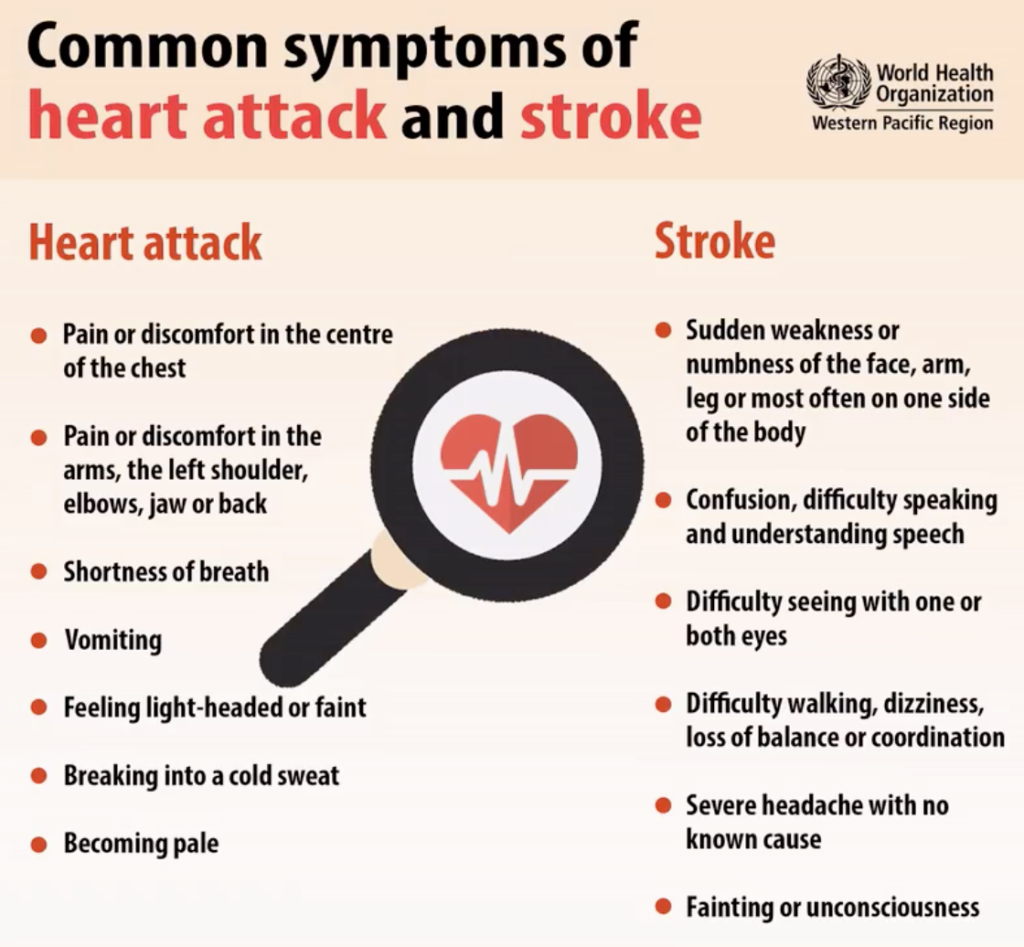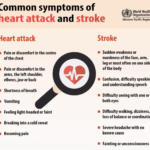Heart Attack and Stroke Symptoms: ideal blood pressure is considered to be between 90/60mmHg and 120/80mmHg. high blood pressure is considered to be 140/90mmHg or higher. low blood pressure is considered to be below 90/60mmHg.
Heart Attack and Stroke Symptoms
Table of Contents
A heart attack occurs when the flow of blood to the heart is severely reduced or blocked. The blockage is usually due to a buildup of fat, cholesterol and other substances in the heart (coronary) arteries. The fatty, cholesterol-containing deposits are called plaques. The process of plaque buildup is called atherosclerosis.
Sometimes, a plaque can rupture and form a clot that blocks blood flow. A lack of blood flow can damage or destroy part of the heart muscle.
What is normal blood pressure by age?
Estimated Blood Pressure Ranges (mm Hg)
| Age | Systolic Range | Diastolic Range |
| Children (2–13 years) | 80–120 | 40–80 |
| Adolescent (14–18 years) | 90–120 | 50–80 |
| Adult (19–40 years) | 95–135 | 60–80 |
| Adult (41–60 years) | 110–145 | 70–90 |
મહિલા અને પુરુષોમાં બ્લડ પ્રેશરનું પ્રમાણ કેટલું હોવું જોઇએ
તમારા શરીરમાં તમારી ધમની પર તમારું લોહી જેટલું દબાણ કરે છે તે દબાણના માપનને બ્લડ પ્રેશર રીડિંગ (Blood Pressure Reading) કહેવાય છે. દિવસ દરમિયાન તમારું બ્લડ પ્રેશર(Blood Pressure) અનેક વખત બદલે છે. એટલે કે જ્યારે તમે સામાન્ય સ્થિતિમાં કે ચિંતા મુક્ત અને ખુશ હશો ત્યારે તમારું બ્લડ પ્રેશર નોર્મલ (Normal Blood Pressure) રહેશે. પરંતુ જ્યારે તમે તણાવ (Tension) કે ભાગદોડમાં હશો ત્યારે તમારું બ્લડ પ્રેશર પણ વધી (High Blood Pressure) જશે. હાઈ બ્લડ લાંબાગાળે પ્રેશર હૃદય, મગજ અને આંખના નુકસાન સહિતના ગંભીર સ્વાસ્થ્ય જોખમો (Health Problems) ઊભા કરે છે. તેવી જ રીતે, લાંબાગાળે લો બ્લડ પ્રેશર સ્વાસ્થ્ય સંબંધિત જોખમો લાવે છે. સદનસીબે, હાઈ અને લો બ્લડ પ્રેશર બંનેને નિયંત્રિત કરવા માટે ઉપયોગી રીતો છે.
બ્લડ પ્રેશર શું છે?
રક્તવાહિનીઓ પર પડતાં લોહીનાં દબાણને બ્લડ પ્રેશર કહેવાય છે. હાઈ બ્લડ પ્રેશરમાં લોહીનું દબાણ વધુ અને લોમાં ઓછું થઈ જાય છે. હાઈ અથવા લો બંને પ્રકારના બ્લડ પ્રેશરમાં તરત જ સારવાર કરાવવી જરૂરી બની જાય છે.
ઉંમર અનુસાર કેટલું બ્લડ પ્રેશર હોવું જોઇએ?
સામાન્ય બ્લડ પ્રેશર 120/80 સુધી માનવામાં આવે છે. પરંતુ બાળકોમાં નોર્મલ બ્લડ પ્રેશરની સ્થિતિ હંમેશાં બદલાતી રહે છે કારણ કે, જેમ-જેમ તેમની ઉંમર વધતી જાય છે તેમ-તેમ તેમનું બ્લડ પ્રેશર વધવા-ઘટવા લાગે છે.
ઉંમર- 21-25
SBP- 120.5
DBP- 78.5
ઉંમર- 26-30
SBP- 119.5
DBP- 76.5
ઉંમર- 31-35
SBP- 114.5
DBP- 75.5
ઉંમર- 36-40
SBP- 120.5
DBP- 75.5
ઉંમર- 41-45
SBP- 115.5
DBP- 78.5
ઉંમર- 46-50
SBP- 119.5
DBP- 80.5
ઉંમર- 51-55
SBP- 125.5
DBP- 80.5
ઉંમર- 56-60
SBP- 129.5
DBP- 79.5
ઉંમર- 61-65
SBP- 143.5
DBP- 76.5
મહિલાઓ
ઉંમર- 21-25
SBP- 115.5
DBP- 70.5
ઉંમર- 26-30
SBP- 113.5
DBP- 71.5
ઉંમર- 31-35
SBP- 110.5
DBP- 72.5
ઉંમર- 36-40
SBP- 112.5
DBP- 74.5
ઉંમર- 41-45
SBP- 116.5
DBP- 73.5
ઉંમર- 46-50
SBP- 124
DBP- 78.5
ઉંમર- 51-55
SBP- 122.55
DBP- 74.5
ઉંમર- 56-60
SBP- 132.5
DBP- 78.5
ઉંમર- 61-65
SBP- 130.5
DBP- 77.5
લો બ્લડ પ્રેશર થવા માટેના કારણો અને લક્ષણો
લો બ્લડ પ્રેશર (હાયપોટેન્શન) સામાન્ય રીતે 90/60 mm Hg (અથવા નીચે) માપવામાં આવે છે. કેટલાક લોકોને હંમેશા લો બ્લડ પ્રેશર હોય છે, તેથી તે દરેક વ્યક્તિ પર આધાર રાખે છે. જો કે, બ્લડ પ્રેશરમાં અચાનક ઘટાડો થવો તે વધુ ગંભીર સ્વાસ્થ્ય સમસ્યાઓનો સંકેત હોઈ શકે છે. નીચેના કારણોસર લો બ્લડ પ્રેશરની સમસ્યા થઇ શકે છે.
- દવાઓ
- રક્તસ્ત્રાવ
- ઉંમર
- ડિહાઇડ્રેશન
- ગર્ભાવસ્થા
- ડાયાબિટીસ
- હ્યદય સંબંધિત સમસ્યાઓ
લો બ્લડ પ્રેશરના લક્ષણો
લો બ્લડ પ્રેશરના પણ ચોક્કસ લક્ષણો નથા. પરંતુ લોકોને અમુક સ્વાસ્થ્ય સમસ્યાઓ આવી શકે છે. જેમ કે, ચક્કર આવવા, બેભાન થઇ જવું, પડી જવું, થાક, નબળાઇ, માથાનો દુખાવો, ગરદન અને પીઠનો દુ:ખાવો અને ઉબકા આવવા જેવા લક્ષણો અનુભવાય તો તાત્કાલિક ડોક્ટર પાસે તપાસ કરાવવી હિતાવહ છે.
બ્લડ પ્રેશર નિયંત્રણમાં રાખવાની ટિપ્સ
- પ્રોસેસ્ડ ફૂડની જગ્યાએ આખા અનાજનો ખોરાક લો. પરંતુ બજારમાં તે ખરીદતી વખતે તેનું ન્યૂટ્રિશન લેબલ અને સોડિયમની માત્રા ચોક્કસ તપાસી લેવી.
- આહારમાં દૂધ, દહીં, ઘરેલુ વસ્તુઓ અને અન્ય લો ફેટ ફૂડ્સ સામેલ કરો.
- દૈનિક આહારમાં ઓછામાં ઓછાં 2 ફળો અને શાકભાજી ખાઓ. પાંદડાવાળાં શાકભાજી, બ્રોકોલી, બ્લુબેરી, તરબૂચ, કેળું વગેરે લો.
- લસણ હૃદય માટે બહુ લાભદાયક હોય છે. તે ખાવાથી રક્ત પરિભ્રમણ યોગ્ય થાય છે અને હાઈ બ્લડ પ્રેશર નિયંત્રણમાં રહે છે.
- જો તમારું બ્લડ પ્રેશર સવારે વધી જાય તો તરત જ 1 ગ્લાસ ગાજરનો જૂસ પી લો.
- હાઈ બ્લડ પ્રેશરને કન્ટ્રોલમાં કરવા અડધા ગ્લાસ પાણીમાં લીંબુનો રસ નિચોવી દર 2 કલાકે પીઓ.
Healthy and unhealthy blood pressure ranges
Learn what is considered normal, as recommended by the American Heart Association.
Note: A diagnosis of high blood pressure must be confirmed with a medical professional. A health care professional should also evaluate any unusually low blood pressure readings.
| BLOOD PRESSURE CATEGORY | SYSTOLIC mm Hg (upper number) | and/or | DIASTOLIC mm Hg (lower number) |
| NORMAL | LESS THAN 120 | and | LESS THAN 80 |
| ELEVATED | 120 – 129 | and | LESS THAN 80 |
| HIGH BLOOD PRESSURE (HYPERTENSION) STAGE 1 | 130 – 139 | or | 80 – 89 |
| HIGH BLOOD PRESSURE (HYPERTENSION) STAGE 2 | 140 OR HIGHER | or | 90 OR HIGHER |
| HYPERTENSIVE CRISIS (consult your doctor immediately) | HIGHER THAN 180 | and/or | HIGHER THAN 120 |
How low is too low for blood pressure?
Within certain limits, the lower your blood pressure reading is, the better. While there is no specific number at which day-to-day blood pressure is considered too low, a reading of less than 90/60 mm Hg is considered hypotension. Hypotension is the term for blood pressure that is too low. The condition is benign as long as none of the symptoms showing lack of oxygen are present.
Symptoms of low blood pressure
Most health care professionals will only consider chronically low blood pressure as dangerous if it causes noticeable signs and symptoms, such as:
- Confusion
- Dizziness or lightheadedness
- Nausea
- Fainting (syncope)
- Fatigue
- Neck or back pain
- Headache
- Blurred vision
- Heart palpitations, or feelings that your heart is skipping a beat, fluttering, or beating too hard or too fast
Underlying causes of low blood pressure
Low blood pressure can occur with:
- Prolonged bed rest (orthostatic)
- Depression or Parkinson’s disease
- Pregnancy: During the first 24 weeks of pregnancy, it’s common for blood pressure to drop.
Decreases in blood volume: A decrease in blood volume can also cause blood pressure to drop. A significant loss of blood from major trauma, dehydration or severe internal bleeding reduces blood volume, leading to a severe drop in blood pressure. - Certain medications: A number of drugs can cause low blood pressure, including diuretics and other drugs that treat hypertension; heart medications such as beta blockers; drugs for Parkinson’s disease; tricyclic antidepressants; erectile dysfunction drugs, particularly in combination with nitroglycerine; narcotics; and alcohol. Other prescription and over-the-counter drugs may cause low blood pressure when taken in combination with high blood pressure medications.
- Heart problems: Among the heart conditions that can lead to low blood pressure are an abnormally low heart rate (bradycardia), problems with heart valves, heart attack and heart failure. Your heart may not be able to circulate enough blood to meet your body’s needs.
- Endocrine problems: Such problems include complications with hormone-producing glands in the body’s endocrine systems; specifically, an underactive thyroid (hypothyroidism), adrenal insufficiency (Addison’s disease), low blood sugar and, in some cases, diabetes.
- Severe infection (septic shock): Septic shock can occur when bacteria leave the original site of an infection, most often in the lungs, abdomen or urinary tract, and enter the bloodstream. The bacteria then produce toxins that affect blood vessels, leading to a profound and life-threatening decline in blood pressure.
- Allergic reaction (anaphylaxis): Anaphylactic shock is a sometimes-fatal allergic reaction that can occur in people who are highly sensitive to drugs such as penicillin, to certain foods such as peanuts or to bee or wasp stings. This type of shock is characterized by breathing problems, hives, itching, a swollen throat and a sudden, dramatic fall in blood pressure.
- Neurally mediated syncope (hypotension): Unlike orthostatic hypotension, this disorder causes blood pressure to drop after standing for long periods, leading to symptoms such as dizziness, nausea and fainting. This condition primarily affects young people and occurs because of a miscommunication between the heart and the brain.
- Nutritional deficiencies: A lack of the essential vitamins B-12 and folic acid can cause anemia, which in turn can lead to low blood pressure.
- Dehydration: Dehydration can sometimes cause blood pressure to drop. However, dehydration does not always cause low blood pressure but may cause other symptoms such as weakness, dizziness and fatigue
What are the signs and symptoms of Heart Attack and Stroke Symptoms?
High blood pressure usually has no warning signs or symptoms, and many people do not know they have it. Measuring your blood pressure is the only way to know whether you have high blood pressure.
What causes Heart Attack and Stroke Symptoms?
High blood pressure usually develops over time. It can happen because of unhealthy lifestyle choices, such as not getting enough regular physical activity. Certain health conditions, such as diabetes and having obesity, can also increase the risk for developing high blood pressure. High blood pressure can also happen during pregnancy.
Symptoms
Symptoms of a heart attack vary. Some people have mild symptoms. Others have severe symptoms. Some people have no symptoms.
Common heart attack symptoms include:
- Chest pain that may feel like pressure, tightness, pain, squeezing or aching
- Pain or discomfort that spreads to the shoulder, arm, back, neck, jaw, teeth or sometimes the upper belly
- Cold sweat
- Fatigue
- Heartburn or indigestion
- Lightheadedness or sudden dizziness
- Nausea
- Shortness of breath
- Women may have atypical symptoms such as brief or sharp pain felt in the neck, arm or back. Sometimes, the first symptom sign of a
- heart attack is sudden cardiac arrest.
આ માહિતી વિવિધ ઉપલબ્ધ વેબસાઈટ પરથી એકઠી કરી અહી મુકવામાં આવેલ છે. આ માહિતી કોઈ રોગનો ઈલાજ નથી. અમે આ માહિતીનું સમર્થન કરતા નથી. બ્લડ પેસર કે હાર્ટએટેક સબંધી કોઇપણ તકલીફ માટે નજીકના ડોક્ટરની જ સલાહ અને સારવાર લેવી જોઈએ. ખાસ ekeshod.in આ માહિતીનું સમર્થન કરતુ નથી.
Some heart attacks strike suddenly. But many people have warning signs and symptoms hours, days or weeks in advance. Chest pain or pressure (angina) that keeps happening and doesn’t go away with rest may be an early warning sign. Angina is caused by a temporary decrease in blood flow to the heart.






